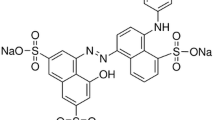Abstract
Some process has been proposed for azo dye degradation and anaerobic bioreactors are one of them, since for their reduction, the dye has to be the electron acceptor. An anaerobic fixed bed bioreactor packed with activated carbon (AC) is proposed to degradate the Reactive Red 272 azo dye. In the present paper a dye degradation mechanism in an anaerobic environment is explained. It is very important to consider the interaction dye-microorganism-AC, because the groups in the AC surface take part in the reaction besides being an excellent carrier for microorganism and an adsorbent for the dye. The aromatic compounds produced in the dye reduction are partially degraded as a function of inlet dye concentration and reactor residence time. In anaerobic environment the aromatic compounds are decomposed through hydroxylation, carboxylation and redox reactions, due to enzymatic reactions.









Similar content being viewed by others
References
APHA-AWWA-WPCF (1989) Standard methods for the examination of water and wastewater, 17va ed. In: Clesceri LS, Greenberg AE, Trussell RR (eds) American Public Health Association, USA
Buckel W, Golding BT (2006) Radical enzymes in anaerobes. Annu Rev Microbiol 60:27–49. doi:10.1146/annurev.micro.60.080805.142216
Chen B-Y (2002) Understanding decolourization characteristics of reactive azo dyes by Pseudomonas luteola: toxicity and kinetics. Process Biochem 38:437–446. doi:10.1016/S0032-9592(02)00151-6
Chen B-Y, Chen S-Y, Lin M-Y, Chang J-S (2006) Exploring bioaugmentation strategies for azo-dye decolourization using a mixed consortium of Pseudomonas luteola and Escherichia coli. Process Biochem 41(7):1574–1581. doi:10.1016/j.procbio.2006.03.004
Donlon BA, Razo-Flores E, Lettinga G, Field JA (1996) Continuous detoxification, transformation, and degradation of nitro phenols in up flow anaerobic sludge blanket (UASB) reactors. Biotech Bioeng 51:439–449. doi:10.1002/(SICI)1097-0290(19960820)51:4<439::AID-BIT7>3.0.CO;2-J
dos Santos AB, Cervantes FJ, Yaya-Beas RE, van Lier JB (2003) Effect of redox mediator AQDS on the decolourisation of a reactive azo dye containing triazine group in a thermophilic anaerobic EGSB reactor. Enzyme Microb Technol 33:942–951. doi:10.1016/j.enzmictec.2003.07.007
Field JA (2002) Limits of anaerobic biodegradation. Water Sci Technol 45(10):9–18
Gerardi MH (2006) Wastewater bacteria. Wastewater microbiology series, Ed. Wiley-Interscience. USA
Griebler C, Safinowski M, Vieth A, Richnow H, Meckenstock R (2004) Combined application of stable carbon isotope analysis and specific metabolites determination for assessing in situ degradation of aromatic hydrocarbons in a tar oil-contaminated aquifer. Environ Sci Technol 38:617–631. doi:10.1021/es0344516
Gonzalez-Gutierrez LV, Escamilla-Silva EM (2007) Anaerobic biodegradation of a reactive red azo dye using an UASB bioreactor packed with activated carbon, World J Microbiol Biotechnol (in review)
HeFang , HuWenrong , LiYuezhong (2004) Biodegradation mechanisms and kinetics of azo dye 4BS by a microbial consortium. Chemosphere 57:293–301. doi:10.1016/j.chemosphere.2004.06.036
Khehra MS, Saini HS, Sharma DK, Chadha BS, Chimni SS (2006) Biodegradation of azo dye C.I. Acid Red 88 by an anoxic-aerobic sequential bioreactor. Dyes Pigment 70:1–7. doi:10.1016/j.dyepig.2004.12.021
Kudlich M, Hetheridge MJ, Knackmuss H-J, Stolz A (1999) Autoxidation reactions of different aromatic o-aminohydroxynaphthalenes that are formed during the anaerobic reduction of sulfonated azo dyes. Environ Sci Technol 33:896–901. doi:10.1021/es9808346
Kumar K, Devi SS, Krishnamurthy K, Gampawar S, Mishra N, Pandya GH, Chakrabarti T (2006) Decolorisation, biodegradation and detoxification of benzidine based azo dye. Bioresour Technol 97:407–413. doi:10.1016/j.biortech.2005.03.031
Meckenstock RU, Safinowski M, Griebler C (2004) Anaerobic degradation of polycyclic aromatic hydrocarbons. FEMS Microbiol Ecol 49:27–36. doi:10.1016/j.femsec.2004.02.019
Miller B (1998) Advanced organic chemistry: reactions and mechanisms. Prentice Hall, USA
Plum A, Rehorek A (2005) Strategies for continuous on-line high performance liquid chromatography coupled with diode array detection and electro spray tandem mass spectrometry for process monitoring of sulphonated azo dyes and their intermediates in anaerobic–aerobic bioreactors. J Chromatogr A 1084:119–133. doi:10.1016/j.chroma.2005.03.001
Schink B (2006) Microbially driven redox reactions in anoxic environments: pathways energetics and biochemical consequences. Eng Life Sci 6(3):228–233. doi:10.1002/elsc.200620130
Sponza DT, Işik M (2005) Toxicity and intermediates of C.I. Direct Red 28 dye through sequential anaerobic/aerobic treatment. Process Biochem 40:2735–2744. doi:10.1016/j.procbio.2004.12.016
Supaka N, Juntongjin K, Damronglerd S, Delia M-L, Strehaino P (2004) Microbial decolorization of reactive azo dyes in a sequential anaerobic–aerobic system. Chem Eng J 99:169–176. doi:10.1016/j.cej.2003.09.010
Tauber MM, Guebitz GM, Rehorek A (2005) Degradation of azo dyes by laccase and ultrasound treatment. Appl Environ Microbiol 71:2600–2607. doi:10.1128/AEM.71.5.2600-2607.2005
van der Zee FP, Villaverde S (2005) Combined anaerobic–aerobic treatment of azo dyes—A short review of bioreactor studies. Water Res 39:1425–1440. doi:10.1016/j.watres.2005.03.007
Wade LG (2004) Química Orgánica, 5 ta edn. Pearson Prentice Hall, España
Ye J, Singh A, Ward OP (2004) Biodegradation of nitroaromatics and other nitrogen-containing xenobiotics. World J Microbiol Biotechnol 20:117–135. doi:10.1023/B:WIBI.0000021720.03712.12
Acknowledgement
The research was funded by Fondos Mixtos—Consejo Nacional de Ciencia y Tecnología del Estado de Guanajuato (Project: 31756).
Author information
Authors and Affiliations
Corresponding author
Rights and permissions
About this article
Cite this article
González-Gutiérrez, L.V., González-Alatorre, G. & Escamilla-Silva, E.M. Proposed pathways for the reduction of a reactive azo dye in an anaerobic fixed bed reactor. World J Microbiol Biotechnol 25, 415–426 (2009). https://doi.org/10.1007/s11274-008-9906-0
Received:
Accepted:
Published:
Issue Date:
DOI: https://doi.org/10.1007/s11274-008-9906-0




